
Sphaeropteris medullaris, synonym Cyathea medullaris, commonly known as mamaku or black tree fern, is a large tree fern up to 20 m tall. It is distributed across the south-west Pacific from Fiji to Pitcairn Island. Its other Māori names include katātā, kōrau, or pītau.
Water fern is a common name for several plants and may refer to:

Alsophila smithii, synonym Cyathea smithii, commonly known as the soft tree fern or kātote, is a species of tree fern from New Zealand.
Blechnum petiolare is a species of fern in the family Blechnaceae. It is endemic to Ecuador and known only from Bolívar Province. When it was first described in the early 20th century, it was known from Chillanes but this area has been heavily disturbed and the species continues to be threatened.
Austroblechnum divergens, synonyms including Blechnum divergens, Blechnum rimbachii and Blechnum floresii, is a species of fern in the family Blechnaceae.

Hymenophyllum nephrophyllum, the kidney fern, is a filmy fern species native to New Zealand. It commonly grows on the forest floor of open native bush. Individual kidney-shaped fronds stand about 5–10 cm tall. In hot weather they shrivel up to conserve moisture, but open up again when the wet returns. This species has very thin fronds which are only four to six cells in thickness. In the Māori language they are also called raurenga.

Cranfillia fluviatilis, synonym Blechnum fluviatile, is a fern known in the Māori language as kiwikiwi. A herbaceous plant, C. fluviatilis is a "hard fern" of the genus Cranfillia in the family Blechnaceae. It was identified by Patrick Brownsey in 1979. Other common names are star fern, creek fern, kawakawa and kiwakiwa.
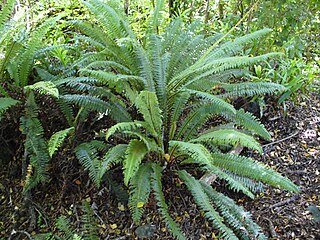
Lomaria discolor, synonym Blechnum discolor, commonly called crown fern, is a species of fern in the family Blechnaceae. This species is endemic to New Zealand. As noted by C. Michael Hogan, this species is found in a number of forest communities in diverse locations within New Zealand, and is sometimes a dominant understory component.

Dendroconche scandens, synonym Microsorum scandens, commonly called fragrant fern, is a species of fern within the family Polypodiaceae. This species is native to parts of New Zealand and Australia, as well as some offshore islands. It has been introduced to South Africa and Zimbabwe. An example occurrence in New Zealand's North Island is in the Hamilton Ecological District where it is associated with a number of other ferns including Icarus filiforme and Lomaria discolor. In general, it is found in lowland and coastal forested regions.
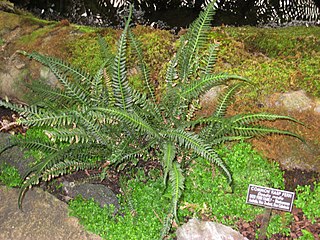
Doodia media, also known as rasp fern, is a fern species in the family Blechnaceae. The species was formally described by botanist Robert Brown in 1810. Distribution of the species includes New Zealand's North Island and the upper part of the South Island. It is also found in Australia and Lord Howe Island.
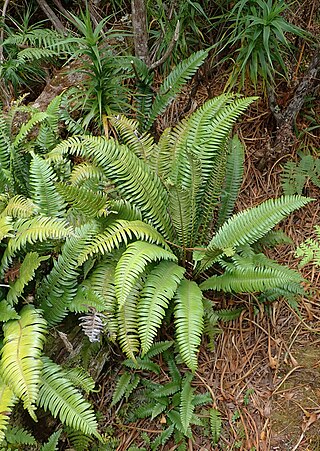
Austroblechnum durum, synonym Blechnum durum, is a species of fern in the family Blechnaceae. The fern is endemic to New Zealand.

Austroblechnum penna-marina, synonym Blechnum penna-marina, known as Antarctic hard-fern, Little Hard Fern, Alpine Hard Fern, alpine water fern and pinque, is a species of fern in the family Blechnaceae. It is a widely distributed fern species in the southern hemisphere, with a natural range including New Zealand, Australia, and South America.
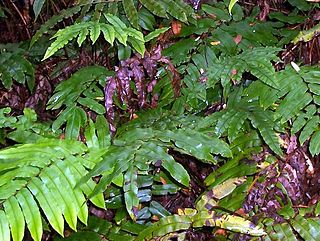
Parablechnum wattsii, synonym Blechnum wattsii, is a common terrestrial fern growing in rainforest and open forest. It is often seen near creeks in much of south eastern Australia, including Victoria, Tasmania, South Australia, New South Wales and Queensland. The specific epithet wattsii honours William Walter Watts (1856-1920). Watts was considered an authority on mosses and ferns and has more than 30 species named for him. Common names by which the species may be called are hard water fern - from its stiff leathery fronds, leech fern - as forest workers often encounter leaches while working in clusters of these ferns, hard hill fern - from the fern's habit and habitat, and red cabbage fern - from the bronze-pink colour of the young fronds resembling cooked red cabbage.

Austroblechnum patersonii, synonym Blechnum patersonii, is a fern in the family Blechnaceae. It is known as the strap water-fern.
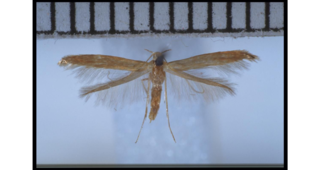
Batrachedra litterata is a species of moth in the family Batrachedridae. It is endemic to New Zealand and has been collected in the North and South Islands. This species has been reared on the fern species Blechnum chambersii. Adults are on the wing in November and December.
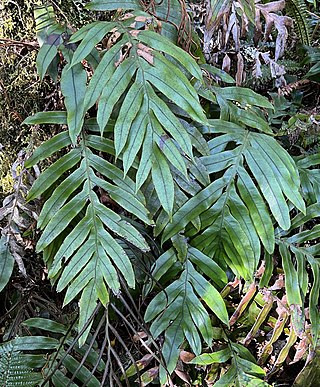
Austroblechnum colensoi, synonym Blechnum colensoi, also known as Colenso's hard fern, waterfall fern or peretao is a species of fern native to New Zealand. It is distributed throughout the North, South and Stewart Islands.

Lomaridium contiguum, synonym Blechnum contiguum, is a fern in the family Blechnaceae. The specific epithet refers to the contiguous lobes of the fronds.

Austroblechnum is a genus of ferns in the family Blechnaceae, subfamily Blechnoideae, according to the Pteridophyte Phylogeny Group classification of 2016. The genus is accepted in a 2016 classification of the family Blechnaceae, but other sources sink it into a very broadly defined Blechnum, equivalent to the whole of the PPG I subfamily.

Icarus is a genus of ferns in the family Blechnaceae, subfamily Blechnoideae, with a single species Icarus filiformis, according to the Pteridophyte Phylogeny Group classification of 2016. The genus is accepted in a 2016 classification of the family Blechnaceae, but other sources sink it into a very broadly defined Blechnum, equivalent to the whole of the PPG I subfamily.
















